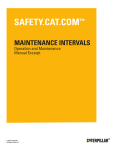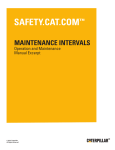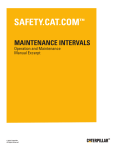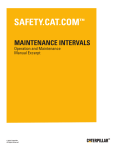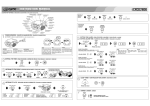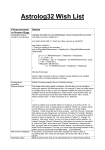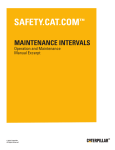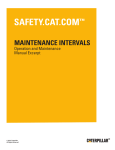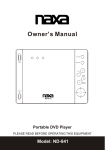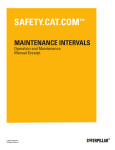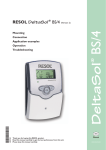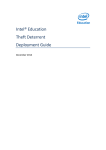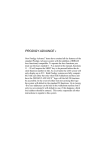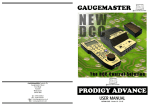Download Your Drive Train Systems Management Guide
Transcript
DRIVE TRAIN ® Your Drive Train Systems Management Guide Your drive train systems play an integral role in equipment operation. Today’s drive trains are more sophisticated than ever, requiring system management techniques to achieve maximum productivity and lower costs. While there are no substitutes for our services, there is much you can do to lower costs. The Drive Train Systems Management Guide enables you to plan for and predict normal wear and avoid abnormal wear on drive train components. It helps you and your operators manage your drive train by: • outlining preventive maintenance techniques. • explaining the importance of S•O•SSM fluid analysis. • providing routine and in-depth inspection information. • exploring repair management options. • detailing training, scheduling, and record keeping. We work with you to manage and maintain your drive train systems effectively—for maximum productivity and life. X Contents Introduction Seven elements of drive train systems management Include all seven elements in your management program Preventive maintenance Make sure oil properly cleans, cools, and lubricates parts Make sure fluid filters effectively control contamination S·O·S fluid analysis Understand S•O•S fluid analysis Use the correct method to take samples Inspections Locate potential problems with thorough inspections Recognize repair indicators Follow an inspection schedule Repair management Control costs and downtime with repair management options Training, scheduling, and record keeping Lower costs with effective training, scheduling, and record keeping 3 3 4 4 5-6 5 6 7 7 7 8-11 8 9 10 12-13 12 14-15 14 DRIVE TRAIN Introduction Get better performance and longer life from your drive train Your machine’s drive train serves one purpose: to transfer engine power to the ground. Transmission and final drive components work together to make this happen. The transmission takes the output from your engine and manipulates it to control speed, direction, and torque. The final drives reduce speed and increase torque. When your machine’s components do their job well, productivity goes up and owning and operating costs stay down. To get maximum performance and life from your drive train, however, you must manage wear. Normal wear is expected and predictable. Abnormal wear is the result of incorrect maintenance and operating techniques, such as extending oil change intervals or inadequately warming up your machine. The Caterpillar® Drive Train Systems Management Guide outlines the seven elements of effective drive train system management— preventive maintenance, S•O•S fluid analysis, inspections, repair management, training, scheduling, and record keeping—to help you get the most out of your drive train at the lowest cost per hour. The Drive Train Systems Management Guide offers information, tips, and ideas you can share with your staff. It is not a technical manual or a substitute for the advice and recommendations of our parts and service experts. You can find specific drive train maintenance requirements in the Lubrication and Maintenance Guide (SEBU6250). 3 Seven elements of drive train systems management Include all seven elements in your management program Preventive maintenance Preventive maintenance includes many techniques—like correctly selecting and changing drive train oil and fluid filters—that help you keep small problems from becoming major repairs. S•O•S fluid analysis S•O•S fluid analysis is the best way for you to monitor what is happening inside your drive train systems. It consists of tests that enable you to forecast wear-related problems. Inspections Inspections combine your daily walkaround checks and our periodic technical analyses. They allow you to detect potential problems and impending failures, so you can schedule maintenance and repairs. Repair management Repair management helps you select beforefailure and after-failure repair options and control repair costs. It allows you to plan and schedule repairs, so you can get your machines back to work quickly and reliably. Training Our training assistance helps you improve the maintenance practices of your staff. It reduces the chance of failures caused by faulty maintenance and helps you lower your owning and operating costs. Scheduling A good scheduling system ensures that maintenance, inspections, and planned repairs are done on time. It helps you prevent the failures caused by overlooked maintenance. Record keeping Record keeping consists of full documentation on machine history, component life, and cost information. It helps you identify high-cost or problem areas, track work flow, control costs, and increase machine resale value. 4 DRIVE TRAIN Preventive maintenance Regular preventive maintenance is the most cost-effective way to keep your drive train systems operating at peak performance. Preventive maintenance: • allows you to schedule downtime and plan for maintenance and repair costs. • helps prevent major failures and failures of related parts. • saves you money because you can often repair before failure. • maximizes parts reusability. • optimizes equipment life to keep your machines on the job. •increases machine resale value. Clean, cool, and lubricate drive train parts with proper oil use Drive train oil performs three main functions: cleaning, cooling, and lubricating transmission and final drive components. Since today’s Cat® drive train systems feature new metals, elastomers, and paper disc materials that require advanced lubrication, you must change oil regularly and properly and use the right drive train oil to achieve top performance. Change oil properly It’s also critical that you change oil properly. You can reduce the chance of contamination by: Change oil regularly Oil provides a protective film to separate transmission and final drive components, which operate with very tight tolerances. Changing oil at proper intervals is critical to realizing maximum component life. We recommend that you change oil every 1000 hours, but that is just a guideline. Actual oil life is determined by many factors, including operating conditions. By monitoring S•O•S fluid analysis results, we’ll help you establish proper intervals. Use the right drive train oil For years, it was standard practice to use the same oil in both engine and drive train systems. Today’s transmissions and final drives, however, require lubrication that engine oils cannot provide. Drive train oil for your transmissions and final drives must meet Caterpillar TO-4 specifications, which include frictional and gear wear requirements. Properly managing change intervals also means you get optimum use of the fluid’s lubricating and protecting properties and maximum component life. Changing fluids too early wastes money because you throw away some useful life. Changing fluids too late allows oil to deteriorate and shortens component life. Determining the best change interval takes some effort, but the reward is significantly lower operating costs. • draining oil when it is warm and agitated. • draining dirty oil as completely as possible. • using a filtered transfer cart to add new oil. Engine oils reduce friction between moving parts. Drive train oils allow some friction between discs and plates as they engage— friction that is critical to proper drive train performance. By using drive train oil instead of engine oil, you dramatically extend disc life. Using Cat Transmission/ Drive Train Oil (TDTO) is the safest way to ensure top drive train performance. In new Cat machines, it can extend transmission disc life up to 45% over a CD/SF TO-2 engine oil. Cat TDTO also: • improves gear wear performance significantly. • eliminates transmission slippage. By properly managing change intervals, you get optimum use of fluid’s lubricating and protecting properties and maximum component life. • controls brake chatter. • increases machine break-out force. • provides greater machine rim pull. 5 Preventive maintenance Control contamination with proper filter use Fluid filters work in unison with your drive train oil to control contamination inside your drive train system. By changing filters regularly and properly and by selecting the right filters, you maintain drive train system cleanliness, reduce component wear, and lower costs. Change filters regularly To keep your drive train system operating at peak performance and reduce the chance of contamination, which can cause component wear and system failure, always change your fluid filters at regular intervals. We recommend changing fluid filters every 500 hours. Change filters properly Old filters contain contaminants, so remove filters carefully at change time to ensure that contaminants do not reenter the drive train system. In addition, keep new filters in their packaging until you are ready to install them. Select the right fluid filters Quality fluid filters feature media that remove harmful particles that can cause component wear. They are resistant to leaks and structural failures and are constructed to ensure every bit of oil passes through the media. Even if only 1% of oil fails to pass through the media, filter efficiency drops and the possibility of contamination increases. To protect transmission and final drive components effectively, Cat fluid filters meet higher standards and more rigid specifications than standard filters. Cat fluid filters feature: • resin-impregnated media to meet Caterpillar’s rigid capacity and efficiency specs. • self-lubricating, free-rotating seal design to prevent bunching, improve sealing, and eliminate leaks. • non-metallic core, which is stronger than metal and eliminates metal contamination. • one-piece “auto-spun” canister design to increase structural strength and prevent possible ruptures. • unique fiberglass spiral roving design to eliminate pleat flexing. • one-piece, molded methane end caps to eliminate leaks and metal contamination. 6 DRIVE TRAIN S•O•S fluid analysis Understand S•O•S fluid analysis Oil sampling at scheduled intervals detects shortcomings in your maintenance procedures and forecasts wear-related problems. Our S•O•S fluid analysis program is well recognized for its ability to detect potential problems early. We perform four types of S•O•S analysis tests on your drive train oil. Use the correct method to take samples Using an oil valve probe • Wear Rate Analysis detects, identifies, and assesses the amount and type of wear metals in oil. The rate at which wear metal particles increase from sample to sample is as important as the quantity of particles in oil. • Oil Cleanliness Analysis uses a particle count test to detect both metallic and nonmetallic debris (such as friction disc material) generated by wear, as well as dirt from outside sources. • Oil Contamination Analysis quantifies silicon— which identifies dirt entry—with spectrometric analysis. Additional tests are performed for contamination by water or glycol, which can enter from oil coolers. Using vacuum extraction S•O•S fluid analysis is different from other analysis programs because it focuses on component condition, not just oil condition. Since we understand your Cat drive train system, we can help you analyze S•O•S reports, determine what additional tests need to be performed, and decide on the proper corrective action. Taking samples regularly is critical because it allows for accurate interpretation. While a single sample may spot contamination or a rapidly progressing failure, only several samples taken at regular intervals will establish trends for your drive train system. We analyze these trends to help you achieve maximum drive train performance. Set the engine at low idle and remove the dust cap from the valve of the compartment you are sampling. • Insert the probe into the valve and collect about 100 ml (4 fl oz) of oil into a waste container. Dispose of the waste oil properly. If the bottle is slow to fill, it may be necessary to increase the engine speed to high idle. • Insert the probe into the valve again and fill the sample bottle about three-quarters full—do not fill to the top. • Withdraw the probe and secure the cap on the bottle. Place the bottle with the completed label into the shipping cylinder. NOTE: Use an oil valve probe for pressurized compartments only. Retrofit valve kits are available for models not equipped with valves. • Oil Contamination Analysis determines the loss of oil’s lubricating qualities. An infrared analysis instrument compares the properties of new oil to those of your used oil to determine if the oil is performing up to specification during the entire oil change period. Take samples regularly Oil analysis is the best way to detect and measure contaminants in your drive train system and head off problems before they result in major expenses. • Filling out label accurately • Turn off the engine and measure and cut new tubing to the length of the dipstick. If the compartment you are sampling does not have a dipstick, cut the tubing so that it reaches about halfway into the oil depth. • Insert the tubing through the head of the vacuum pump and tighten the retaining nut. The tubing should extend about 4 cm (1 in) beyond the base of the vacuum pump head. • Install a new sampling bottle onto the vacuum pump head and insert the end of the tubing into the oil—do not allow the tube to touch the bottom of the compartment. • Pump the vacuum pump handle to create a vacuum. Fill the bottle about three-quarters full—do not fill to the top. • Withdraw the tubing, remove the bottle from the vacuum pump, and secure the cap on the bottle. Place the bottle with the completed label into the shipping cylinder. Providing complete information on the sample label makes processing your sample easier. Make sure you include important information like: • • • • machine model and serial number. service meter units on equipment and oil. whether or not the oil was changed when the sample was taken. amount of make-up oil added since last oil change. 7 Inspections Locate potential problems with thorough inspections You and your operators can take the first step in inspections by “listening” to your equipment. A good inspection program combines your daily inspections with our periodic in-depth analyses to: Utilize our inspection services We offer a number of diagnostic and repair services to help you understand warning signs. These services will help you make informed repair decisions. • locate potential problems before they become major repairs. • Repair Indicator Evaluation requires service records, machine hours, and repair indicators. We talk with your operators and evaluate S•O•S reports and trends, magnetic plug inspection findings, leaks, noises, and performance problems. • schedule drive train maintenance and service. • plan and control your operating costs and downtime. Perform regular inspections Your daily visual inspection routine should include a complete visual and operational check of your drive train system. Cat drive train components will generally indicate problems with advanced warning signs, such as strange noises, leaks, slippage, and overheating. We can help you with these inspections by: • providing customized machine checklists. • training your operators to perform daily walkarounds. • teaching your operators to recognize repair indicators. Final drive warning signs Performing proper maintenance and taking action when telltale warning signs appear can prevent catastrophic gear and bearing failure. Call us if you notice: • oil leaks. • large metal particles on the magnetic plug. • unusual noises or vibrations. Transmission warning signs The chart on the following page summarizes warning signs, their possible causes, and recommended actions. 8 • Technical Analysis Inspection (TA) requires advanced diagnostic inspection equipment and consists of a comprehensive visual inspection, plus a repair indicator review and evaluation. After a thorough analysis, we’ll issue a recommendation based on our TA findings. • Repair Determination Inspection (RDI) requires a thorough internal inspection and is performed when TA results suggest further inspection is necessary. It consists of a guaranteed price for component disassembly and evaluation. After the evaluation, we will give you a specific repair option recommendation or a guaranteed repair quote. DRIVE TRAIN Inspections Recognize repair indicators Indicators Possible Causes Options S·O·S results S•O•S Fluid Analysis provides the best insight into internal transmission wear and potential failure. Customer/Dealer Discussion Overhaul Management Guide (OMG) OMG indicates estimated life to overhaul and indicates how you can extend that time by changing operation and maintenance factors. Customer/Dealer Discussion Hesitation Worn plates and discs Wrong oil used Linkage out of adjustment Incorrect pressure settings Low fluid level Technical Analysis Inspection Repair Determination Inspection Customer/Dealer Discussion Slippage Worn plates and discs Linkage out of adjustment Low fluid level Incorrect pressure settings Wrong oil used Technical Analysis Inspection Repair Determination Inspection S•O•S Fluid Analysis Unusual noises Worn gears/worn bearings Dirt entry Aeration/cavitation Low fluid level Technical Analysis Inspection Repair Determination Inspection Customer/Dealer Discussion Vibration Bent drive shaft Gear failure Bearing failure Technical Analysis Inspection Repair Determination Inspection S•O•S Fluid Analysis Customer/Dealer Discussion Overheating Wrong oil used Plugged radiator Worn pump Worn pressure relief valve Worn or damaged seals Worn/dirty control valve Technical Analysis Inspection Repair Determination Inspection S•O•S Fluid Analysis Customer/Dealer Discussion Debris in filter/on magnetic screen Dirt entry Wrong oil used Extended oil change period Worn gears or bearings Disc disintegration S•O•S Fluid Analysis Customer/Dealer Discussion Leaks Worn, hard, or cracked seals Repair Determination Inspection Customer/Dealer Discussion Bent or damaged lines External damage Technical Analysis Inspection Repair Determination Inspection Transmission service meter hours Our PSSRs are trained to use service meter hours as a repair indicator. S•O•S Fluid Analysis Customer/Dealer Discussion Operator discussion Talking with your machine’s operator can reveal many potential transmission problems. Repair Determination Inspection 9 Inspections Follow an inspection schedule 500-hour or quarterly check (reconditioned or rebuilt machines) Service meter hours provide an easy way to structure checks and inspections. These scheduled checks can help you identify problems before they become serious. • Change fluid filters. • Inspect for oil leaks on both sides of sprockets. • Replace seals and/or bearings if leakage is noticeable. Refer to the Service Manual or call us for the correct replacement and adjustment procedure. • Obtain final drive oil samples for S•O•S Fluid Analysis. • Obtain transmission oil sample for S•O•S Fluid Analysis. Do not, however, substitute these checks for the specific information contained in the Lube and Maintenance Guide (SEBU6250). 1000-hour or six-month check Low Sprocket Tractors and Powershift Track Loaders Adjust the sprocket hub bearings. 250-hour or monthly check Check final drive seals daily for leaks. 10-hour or daily check • Complete walk-around inspection. • Check final drive seals for leaks. 10 • Check final drive oil level. Position one final drive so oil level is horizontal. Drain plug should face downward. Oil level should be at the bottom of the filler plug opening. Clean the magnet and add oil if necessary. • Remove the fill plug and maintain the oil level to the bottom edge of the plug opening. • Look for oil leaks if the level is noticeably low—a substantial leak indicates that seals and bearings may need replacement. • Change the oil on both sides. • Remove the fill and drain plugs and allow oil to drain. • Check the magnetic plugs (if equipped) for metal particles. If particles are present, schedule a repair as soon as possible. • Wipe particles off the magnet and retain these particles for comparison purposes at the next change interval. • Clean and reinstall the drain plug. • Refill to the bottom edge of the fill plug opening with Caterpillar Transmission/Drive Train Oil or oil meeting Caterpillar TO-4 specifications. • Clean and reinstall the fill plug. 2000-hour or annual check • Adjust the sprocket hub bearings (refer to the Service Manual for proper procedure or give us a call). • Adjust valves. • Change final drive oil. DRIVE TRAIN Wheel Loaders and Integrated Toolcarriers 250-hour or monthly check 2000-hour or annual check • Check final drive oil level. • Position one final drive so the oil level is horizontal. Drain plug should face downward. Oil level should be at the bottom of the filler plug opening. • Clean the magnet and add oil if necessary. Perform a walk-around inspection daily. Remove, clean, and reinstall the fill plug every 2000 hours or annually. • Change the oil in the front and rear differentials and final drives. • Park the machine on level ground and position each wheel with the drain plug at the lowest point. • Remove each final drive drain plug and drain the oil. • Remove the front and rear differential drain plugs and drain the oil. • Clean and reinstall all differential and final drive drain plugs. • Remove the differential fill plug from the front axle. • Fill the front differential and final drives with oil that meets Cat TO-4 specifications. • Clean and reinstall the fill plug. • Repeat the filling process for the rear axle housing. • Operate the machine for one hour, then stop and inspect for leaks. • Remove the fill plugs and maintain the oil level to the bottom of the opening. If the oil level is above the opening, do not allow the oil to drain to the bottom of the opening. • Reinstall the fill plug. • Add oil to bring the oil level to the bottom of the fill plug opening. • Use this procedure on both the front and rear axles. 10-hour or daily check • Complete walk-around inspection. • Check final drive seals for leaks. • Check lubricant levels in the front and rear differentials and final drives if leaks develop or are suspected. • Operate the machine a few minutes to allow the oil to reach a common level before checking it. • Park the machine on level ground, apply the parking brake, and stop the engine. • Add lubricant to bring the oil level to the bottom of the fill plug opening. • Repeat this procedure on the rear axle housing. 500-hour or quarterly check (reconditioned or rebuilt machines) • Change fluid filters. • Align each wheel with the magnetic drain plug up. Remove the plug and inspect for metal particles. If present, schedule a repair as soon as possible. Wipe particles off the magnet and retain them for comparison purposes at the next inspection. • Obtain final drive oil samples for S•O•S Fluid Analysis. • Obtain transmission oil sample for S•O•S Fluid Analysis. 11 Repair management Control costs and downtime with repair management options Preventive maintenance, S•O•S fluid analysis, and inspections help you catch problems in their earliest stages. With a good drive train management program that includes these three steps, you can make informed decisions about maintenance and repair—optimizing repair timing and minimizing repair costs. Repair management helps you control repair costs and downtime by enabling you to select options at the time of repair. To take advantage of repair management, you must respond to repair indicators quickly—so you can repair before failure. Respond to repair indicators quickly Your Cat drive train system is built to help you avoid costly drive train failure. Certain components are designed to wear, and your drive train will indicate when they need replacement. Responding quickly to the repair indicators listed on page 9 allows you to choose before-failure repair options and replace worn components before they cause major damage. Before-failure repairs Overhaul Management Guide Repair before failure to save time and money Repairing before failure gets your machines back to work sooner and costs two to three times less than the price of after-failure repairs. Our before-failure repair options: The Overhaul Management Guide (OMG) can significantly reduce your owning and operating costs. When used with other drive train management techniques, OMG helps us identify estimated life to before-failure overhaul for your transmission and final drives. It also: • indicates how you can extend the time for an overhaul by changing operating and maintenance factors. • provides increased opportunities for repair before failure. • help prevent major failures and failure of related parts. • maximize parts reusability. • allow you to schedule downtime and plan costs. • maximize equipment life and keep your machine on the job. • allows for more accurate budgeting and scheduling of repairs. Contact our parts and service professionals to schedule a demonstration of OMG. Transmission Rebearing and reseal Rebearing and reseal is recommended when S·O·S results, a visible leak, or compartment hours signal a need for repair, or when another part of the common oil system fails and spreads debris into the transmission. This procedure includes disassembly and assembly of the transmission arrangement and replacement of all bearings, seals, gaskets, and locks. We also clean and inspect all other parts to ensure they meet tolerance specifications. 12 DRIVE TRAIN Before-failure overhaul Upper pinion rebearing and reseal Before-failure overhaul is recommended when the transmission is slipping, hesitating, or overheating. Other indicators include friction material and small iron particles in screens and filters. This repair applies to operable transmissions only and includes a rebearing and reseal, plus replacement or reconditioning of other selected parts as needed. Upper pinion rebearing and reseal is recommended when S•O•S reports show unacceptable wear or contamination. It includes removal and installation of the fuel tank, floor cover plates, steering clutch and brake packs, and upper pinion bearings and seals. Steering clutch and brake reconditioning Complete component replacement Before-failure overhaul Final drive Reseal Rebearing and reseal is signaled by excessive leaks, elevated S·O·S results, or target hours. It includes disassembly and reassembly; replacement of all bearings, seals, gaskets, and miscellaneous hardware; oil change; operational tests; and removal and installation of track. A brake inspection is also included. After-failure overhaul includes a rebearing and reseal, plus replacement or reconditioning of most other parts as needed. Complete component replacement includes both exchange and new replacement components. Exchange components may be the preferred option when your application or job situation demands minimum downtime. Final drive Rebearing and reseal After-failure overhaul Steering clutch and brake reconditioning includes replacement and reuse of clutch plates and discs, relining of brake band assemblies, and inspections and adjustments to ensure proper steering and brake performance. Before-failure overhaul can be performed provided no gears, shafts, bearings, or external parts are broken. It includes rebuilding the entire final drive, most parts and labor to remove the axle, and rebuilding the differential and both final drives. All parts that meet Caterpillar reusability guidelines are reinstalled. Brake repairs can be included at your request. Reseal is required when oil leaks are discovered during inspections. It includes disassembly and reassembly of the final drive, repair or replacement of needed seal components, disassembly required to reach the seal areas in the axle (both final drives and brakes plus the differential), brake inspection, and seal replacement. For low sprocket machines, this repair includes adjustment of the sprocket hub bearing. Transmission After-failure repairs Control costs with our after-failure repair options Repairing before failure is the best way to reduce your downtime and costs. If your drive train system does fail, however, we are in the best position to help you control costs and save time. We keep part replacement costs to a minimum, using Cat Parts Reusability Guidelines and replacing only damaged components. We also stock Cat Exchange parts (including Cat Reman components), which carry the same warranty as new components but cost much less. After-failure overhaul After-failure overhaul is recommended when large pieces of metal are discovered during magnetic plug inspections, when failure occurs, or when broken parts are discovered during before-failure procedures. It includes removal and replacement of the entire axle group and a complete rebuild of both final drives, the differential, and brakes. Brake actuating mechanisms located outside the axle system may require additional repairs. All rebuilt units are fully reconditioned using new Caterpillar parts when needed. Entire final drive modules and axle groups are available for many models. Exchange components may be preferred if your work demands minimum downtime. 13 Training, scheduling, and record keeping Lower costs with effective training, scheduling, and record keeping Training, scheduling, and record keeping may be the most important elements of drive train system management because of their impact on other elements. We offer a variety of training, scheduling, and record-keeping tools that will help you manage your drive train systems and lower your costs. Train your staff Your operators are the key to getting maximum life from your drive train system. An effective, ongoing training program ensures that they operate and maintain your drive train system properly. It also helps you lower costs by reducing the chance of drive train failures caused by faulty maintenance practices. We work with you to customize a training program for your personnel by: • making sure they know proper start-up and shut-down procedures. • reviewing maintenance procedures to ensure they follow recommended lube and maintenance guidelines. • teaching them to recognize and react to repair indicators. • demonstrating the correct method for taking S•O•S samples. • explaining the proper way to change drive train oil and fluid filters. • outlining daily walk-around inspections. Train your staff to avoid abusive operating practices Changing direction Backing up Working on frozen undercarriage Incorrect High-speed direction changes can cause severe shock loading of final drive gear teeth. Incorrect Backing over stumps or off the low-boy causes your machine to hit the ground with the full weight on the sprockets. Something must give—and it might be the final drive gear teeth. Incorrect Working on a frozen undercarriage may cause the tracks to freeze solid. Any attempt to drive your machine imposes tremendous loads on the final drive gear teeth. Correct Avoid backing over stumps or off the low-boy. Correct In cold climates, when operating in mud prior to an extreme temperature drop, block the machine up to get the tracks out of the mud. Correct Shift properly. When moving from full speed reverse to first speed forward, shift down or stop. 14 DRIVE TRAIN Develop effective schedules Good scheduling means maintenance, inspections, and planned repairs are done on time, so you can prevent drive train failures caused by overlooked maintenance. Your scheduling program doesn’t need to be complex—just effective. We can help you develop an effective scheduling system with a record-keeping and control systems manual (PEGP6808). We can also help you set up and use the Maintenance Control System (MCS), a computer program that keeps up-to-date information on the maintenance status of your drive train (JERD2107). Another record-keeping program we offer is the Preventive Maintenance Planner (PMP), a computer program that lets you consolidate individual drive train maintenance requirements (SERD0162). PMP organizes and prints an itemized checklist that shows exactly what you want done at a certain interval, including a list of the parts and fluids required. We can provide computerized checklists and parts lists or help you customize your own. With PMP, you can complete maintenance on schedule, summarize the costs associated with each drive train maintenance interval, and reduce your overall maintenance costs. MCS lets you know when drive train repairs and maintenance are needed, verifies when they are completed, and provides detailed cost information. With MCS, you receive cost-per-hour information, availability reports, and summaries of labor hours, costs, and downtime for each completed drive train job. Keep accurate records An accurate record-keeping system documents drive train history by detailing component life and cost information. It enables you to locate problem areas that may cause higher costs or increased downtime. We can help with: • record-keeping and control systems manual (PEGP6808). • time and cost record booklet (PEEP0694). • work order systems manual (PEGP6809). • MCS (JERD2107). 15 For more information, see us today or visit Caterpillar’s web site at http://www.CAT.com ® X PEDP7027-01 © 1997 Caterpillar Printed in U.S.A.
















